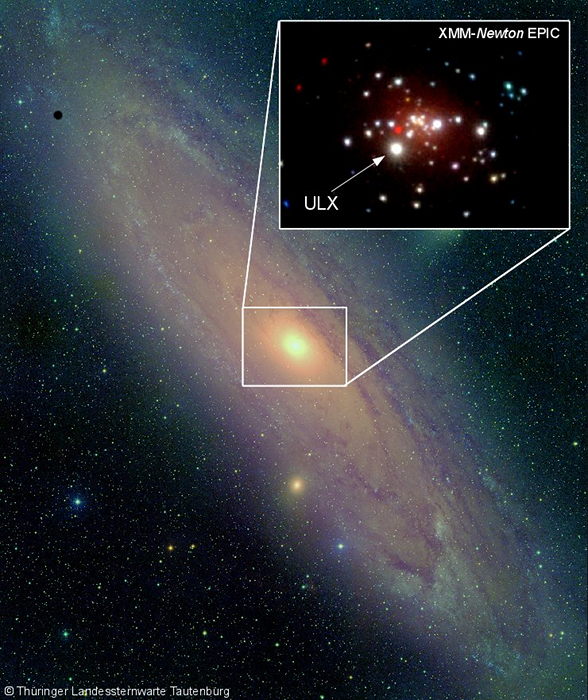
 Credit: MPE
Credit: MPE
ULX Unmasked
Black holes are defined by their mass. Some, the so-called stellar mass black holes have masses close to the mass of the sun, or a bit larger. Others, the supermassive black holes, have masses of millions or billions of times the mass of the sun, and generally power high energy activity at the centers of galaxies. But evidence for black holes with masses between the stellar and supermassive variety, the "intermediate mass" black holes, is hard to come by. The identification of ultra-luminous X-ray sources, or ULXes, by the Chandra X-ray Observatory, the XMM-Newton X-ray observatory, and others, gave what some astronomers believed was the first evidence of black holes with masses of hundreds or thousands of solar masses. An ultra-luminous X-ray source is one which emits an enormous amount of high-energy X-rays, a much larger amount than emitted by most stellar mass black holes. But the exact nature of these ultra-luminous X-ray sources has been hotly debated. A new study of a relatively nearby ULX in the Andromeda galaxy has shown that, at least in this one instance, this particular ULX is probably a "normal", stellar mass black hole. Astronomers using XMM-Newton, Chandra, the Swift Gamma-Ray observatory, and the Hubble Space Telescope were lucky enough to catch this ULX in an X-ray outburst, and to monitor the decrease in X-ray emission from the maximum. The decline in emission followed a characteristic behavior of other, normal stellar mass black hole binary systems. The image above shows an optical image of the Andromeda galaxy, along with an inset X-ray image from XMM-Newton showing the location of the ULX. This suggests that, at least this particular ULX is a normal black hole of about 13 times the mass of the sun, which just happens to be accreting material and spewing out X-rays at an enormous rate. It still remains to be seen whether this means all other ULX systems are similar, or are some really powered by intermediate-mass black holes.
Published: February 27, 2012
<
HEA Dictionary ● Archive
● Search HEAPOW
● Other Languages
● HEAPOW on Facebook
● Download all Images
● Education ● HEAD
>

Each week the HEASARC
brings you new, exciting and beautiful images from X-ray and Gamma ray
astronomy. Check back each week and be sure to check out the HEAPOW archive!
Page Author: Dr. Michael F. Corcoran
Last modified Monday, 26-Feb-2024 17:22:20 EST


